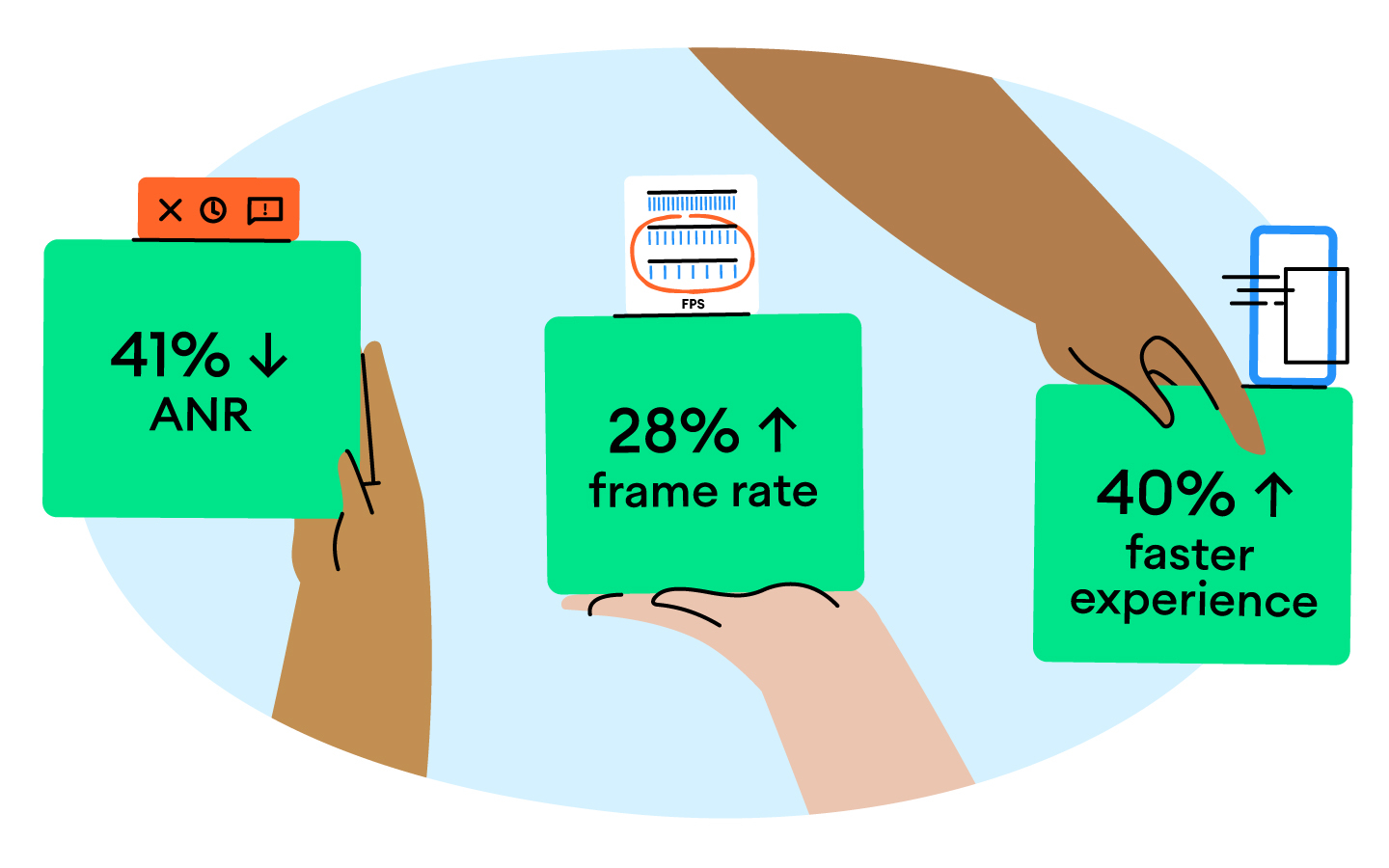듀오링고는 세계에서 가장 인기 있는 언어 학습 앱입니다. 과거에는 어려웠던 것을 쉽고 재미있게 들을 수 있게 해주는 Duolingo입니다. 이 경쾌한 언어 환경을 위해서는 끊임없이 새로운 기능과 실험을 지원하며, 이러한 모든 기능을 제공할 수 있는 원활하게 실행되는 앱이 필요합니다. Duolingo 입장에서, 전 세계 어디에서든 기기에서 앱이 반응하지 않으면 학습자의 의욕을 상실할 수도 있습니다. 이를 통해 우수한 앱 역량을 갖추게 되었고, 특히 초급자용 휴대전화에서 앱을 추적하는 CEO를 포함해 수강생의 60%가 사용하는 Android 기기에서 더욱 그렇습니다. 그래서 Duolingo의 Android 개발팀은 '앱이 응답하지 않음' 오류가 증가하고, 프레임이 떨어지고, 심지어 손으로 작성한 불만사항이 접수되자 즉시 조치를 취했습니다.
그 결과, 앱 성능 문제의 원인을 곧 밝혀냈습니다. 기존 소프트웨어 아키텍처가 팀 성장에 맞춰 제대로 확장되지 못했다는 것입니다. 필수적인 업데이트로 인해 앱의 성능 저하가 발생하고 있었습니다. 개발자들은 버그 수정에 더 많은 시간을 투입하고 새로운 수익 창출 기능을 출시하는 데 할애하지 않았습니다. 오래된 소프트웨어 아키텍처는 회사와 팀의 속도, 무엇보다도 사용자 경험에 부정적인 영향을 미치기 시작했습니다. 코드베이스를 처음부터 다시 빌드해야 했습니다.
진행 방법
초반에 팀은 좌절했습니다. 지금 이 사안이 최우선순위에 맞을까요? 한 그룹은 계속해서 새로운 기능을 출시하고 수익을 창출하는 것이 더 중요하다고 생각했으며, 다른 그룹은 Android 재부팅에 모든 관심을 집중하는 것이 미래에 도움이 될 것이라고 생각했습니다. 결국 그들은 회귀에 맞서기 위한 노력이 증가하면 로드맵이 완전히 탈선될 위험이 있다는 합의에 도달했습니다. 온 힘을 다해야 했습니다.
팀에서는 점점 인기 있는 솔루션을 채택했습니다. 그들은 Model-View-ViewModel을 사용하여 앱을 다시 작성하기로 결정했습니다. Model-View-ViewModel은 개발자가 관심사를 명확하게 구분하여 앱의 아키텍처를 간소화할 수 있도록 Google에서 지원하는 소프트웨어 패턴입니다. MVVM을 사용하면 그래픽 사용자 인터페이스 (뷰) 개발을 비즈니스 로직 (모델) 개발에서 분리할 수 있습니다. 명확하고 합의된 패턴을 수립하여 새로운 기능에 대한 접근 방식을 조정하고 신입 개발자 온보딩을 보다 수월하게 만들 수 있습니다.
각 기능을 별도의 모듈식으로 분할한 덕분에 팀의 생산성을 빠르게 회복할 수 있었습니다. 팀은 소규모 그룹을 배정하여 각 기능을 동시에 작업할 수 있게 함으로써 속도를 높이면서 오류를 줄일 수 있었습니다.
팀은 Android 버전과 기기에서 일관되게 작동하는 코드를 작성할 수 있도록 Dagger와 Hilt를 비롯한 Android Jetpack의 라이브러리로 이 새로운 아키텍처를 구현했습니다. 이러한 두 가지 추가 기능으로 더 나은 캡슐화된 기능을 만들고 Android의 내장 모듈을 더 효율적으로 활용할 수 있었습니다.
결과
이러한 성과는 Android, 특히 엔트리 레벨 기기에서 학습자의 경험을 크게 개선합니다. 또한 플래그십 기기에서 더 매끄러운 애니메이션으로 반응성이 향상된 앱을 만들 수 있었습니다. 일일 '앱이 응답하지 않음' 또는 ANR 발생률이 41% 감소했습니다. 앱이 타겟 프레임 속도 아래로 떨어진 시간의 비율이 28% 감소했습니다. 가장 중요한 점은 사용자가 주요 화면을 스크롤할 때 속도가 40% 증가했다는 것입니다.

손을 들고 메모를 하는 것으로 ANR 발생률이 41% 감소하고 프레임 속도가 28% 향상되었으며 사용자 환경이 40% 빨라졌습니다.
전체 재부팅에 8주가 걸렸으며 앱은 모든 Duolingo 학습자에게 훨씬 더 매력적이고 즐거워졌습니다. 이후 6개월 동안 팀은 새로운 중대한 성능 저하를 기록하지 않아 배송 수익 창출 기능에 다시 집중할 수 있게 되었습니다. 품질에 집중하기로 한 결정은 효과가 있었습니다.
이러한 사명을 완수한 Duolingo는 세계 최고의 언어 학습 앱이 되었습니다. 접근성을 저해하지 않으면서 최첨단 교육 환경을 조성하는 등 우수한 앱 성능을 갖추기 위한 노력 덕분에 이러한 목표를 달성할 수 있었습니다.
시작하기
Duolingo가 어떻게 Jetpack의 라이브러리를 통합했는지, 그리고 Model-View-ViewModel이 앱을 어떻게 개선했는지 자세히 알아보려면 Google의 개발자용 기술 우수사례를 읽어 보세요.

